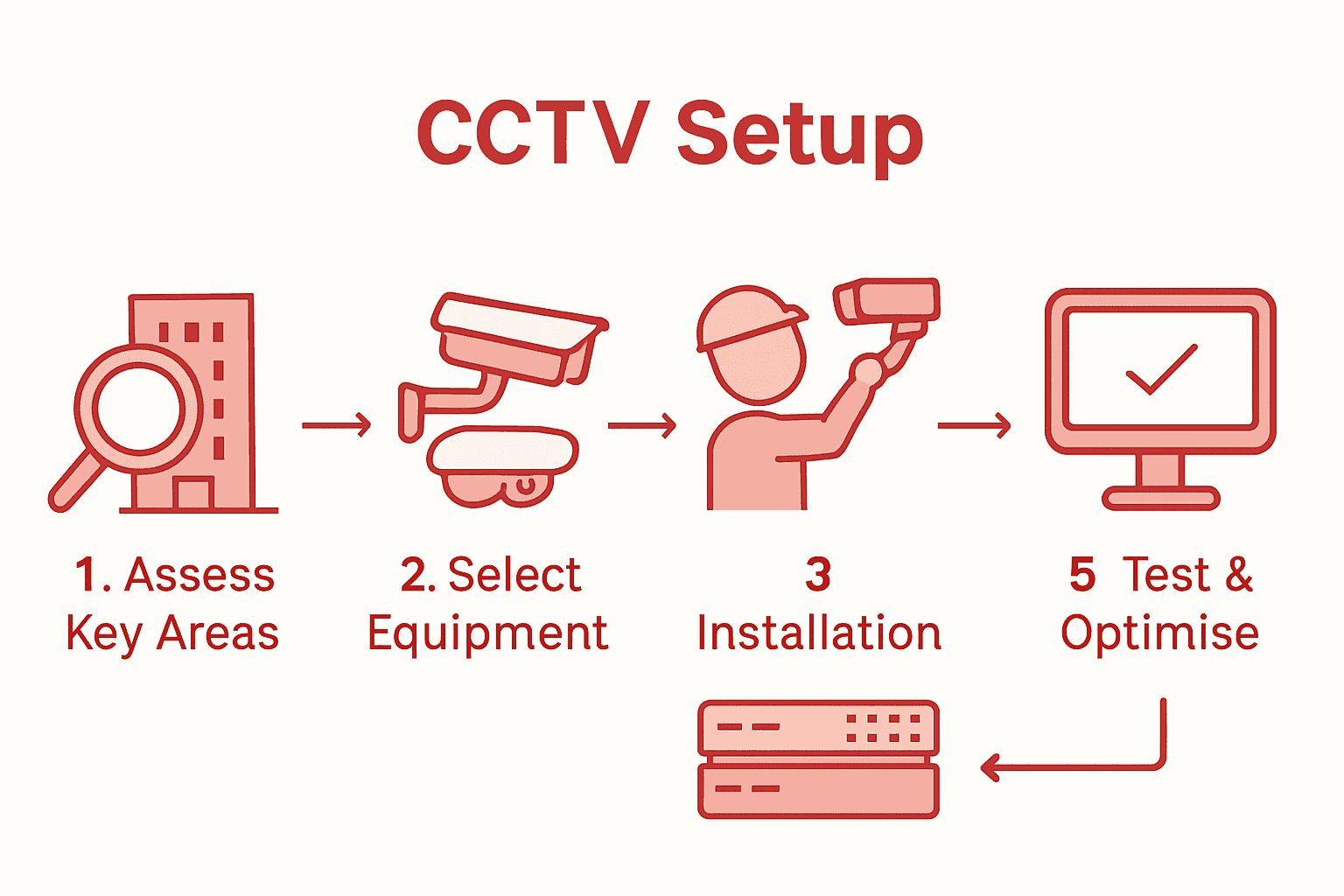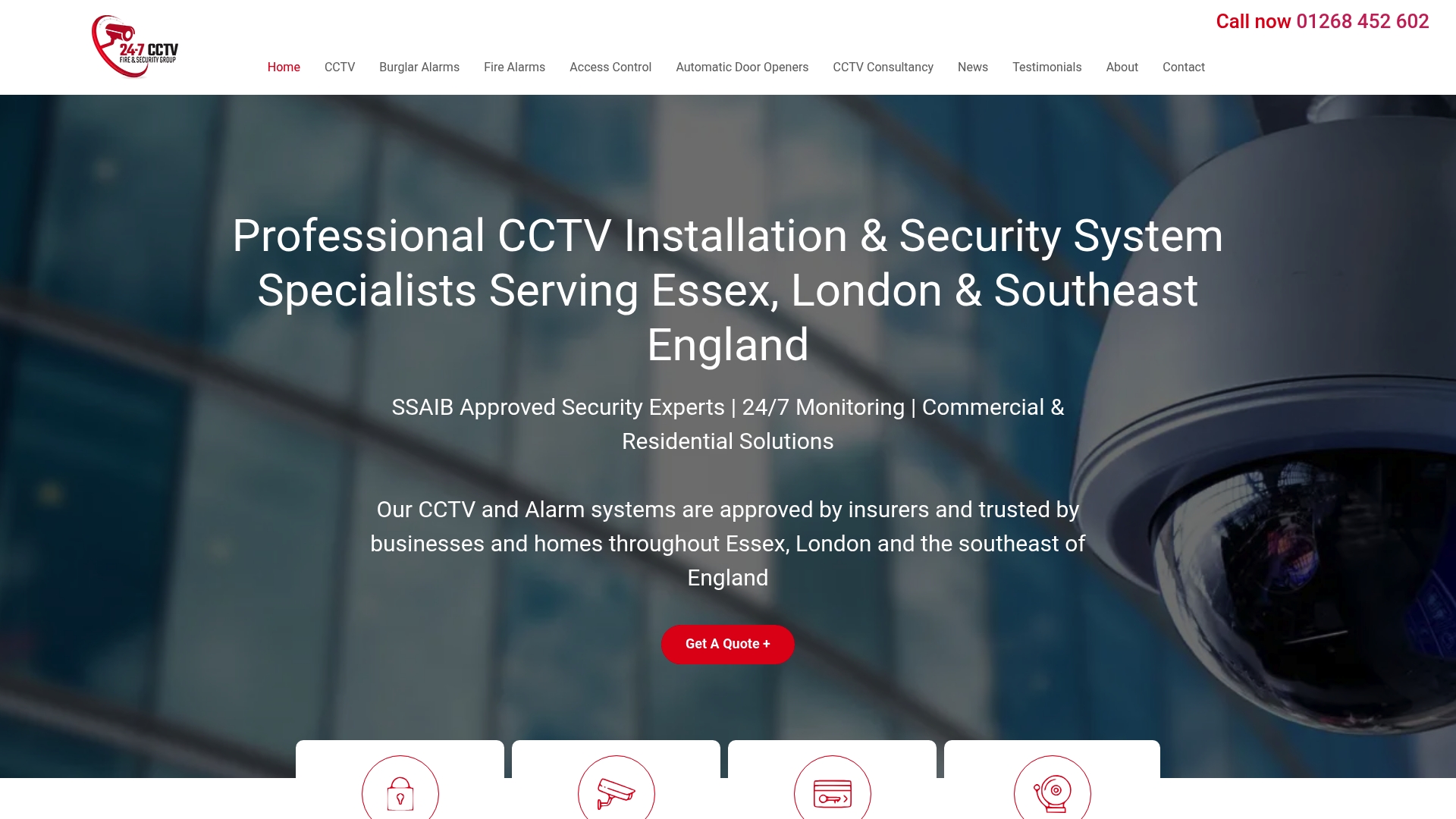More than 60 percent of business thefts happen in areas where security cameras miss key angles or leave blind spots. Protecting your property requires more than just installing cameras anywhere you find space. Understanding exactly where to position each camera and how to select the right system can make all the difference between basic surveillance and true peace of mind. This guide helps you build a smarter, stronger CCTV network so you can watch over every corner of your business with confidence.
Table of Contents
- Step 1: Assess Key Areas And Determine Camera Placement
- Step 2: Select Appropriate CCTV Equipment For Your Site
- Step 3: Install Cameras And Run Necessary Cabling
- Step 4: Configure DVR/NVR And Connect System Components
- Step 5: Test System Functionality And Optimise Camera Views
Quick Summary
| Key Point | Explanation |
|---|---|
| 1. Identify strategic camera placements | Map your premises to spot security gaps and ensure cameras cover high-risk areas effectively. |
| 2. Choose suitable CCTV technology | Select cameras based on your environment and needs, focusing on features like resolution and special capabilities. |
| 3. Prioritize professional installation | Engage experts to install and route cables, enhancing performance and preventing vulnerabilities. |
| 4. Configure DVR/NVR correctly | Ensure proper connections and settings in your recording system for optimal surveillance data management. |
| 5. Regularly test and optimise your system | Frequently check camera views and system functionality to maintain comprehensive security coverage and adjust settings as needed. |

Step 1: Assess Key Areas and Determine Camera Placement
Pinpointing the right camera locations transforms your CCTV system from basic surveillance to a strategic security solution. This crucial first step involves carefully mapping out your business premises to identify vulnerability points and high-traffic zones where monitoring provides maximum protection.
Start by conducting a comprehensive walkthrough of your entire property. Focus on critical areas such as entry and exit points entry doors, loading docks, reception areas, cash handling zones, and storage spaces. Your goal is creating overlapping camera coverage that eliminates potential blind spots. Consider both external and internal spaces strategically placing cameras to capture clear views of movement paths. For instance, position cameras overlooking car parks facing entrances and key exterior perimeters.
A professional tip when determining camera placement involves understanding different viewing angles. Wide-angle cameras work brilliantly for open spaces like warehouses or retail floors tracking overall movement. Narrow focus cameras excel at monitoring specific points like safes, cash registers, or restricted access areas. Where to Put & Install CCTV Cameras: 6 Key Points provides additional insights into strategic camera positioning.
Remember that effective camera placement requires balancing comprehensive coverage with privacy considerations. Avoid pointing cameras directly into private spaces like changing rooms or staff break areas. Your ultimate objective is creating a security network that protects your business assets while respecting professional boundaries.
Step 2: Select Appropriate CCTV Equipment for Your Site
Selecting the right CCTV equipment is a strategic decision that directly impacts your business security effectiveness. Your goal is to choose technology that provides comprehensive surveillance while matching your specific operational requirements and budget constraints.
Begin by evaluating your site’s unique characteristics. Consider factors like indoor versus outdoor environments, lighting conditions, and required resolution quality. For large warehouses or expansive retail spaces, you might need high resolution cameras with wide angle capabilities. Smaller offices might require more compact dome cameras with precise focusing abilities. When exploring camera types look for features like night vision infrared capabilities motion detection and weatherproof ratings for external installations.
Understanding modern security technology is key. 6 Key CCTV System Features to Look For highlights essential technological considerations like digital storage options network connectivity and remote viewing capabilities. Professional grade systems often include intelligent analytics that can differentiate between routine movement and potential security threats saving you time and reducing false alarm incidents.
A critical recommendation is investing in scalable equipment. Choose systems that allow future expansion and integration with additional security technologies. Your CCTV setup should grow alongside your business adaptable to changing security landscapes and emerging technological innovations. Remember that cheaper options might save money initially but could compromise long term security effectiveness.
Step 3: Install Cameras and Run Necessary Cabling
Installing CCTV cameras and running cabling requires precision and careful planning to ensure optimal system performance and reliability. Your goal is creating a robust surveillance infrastructure that provides seamless monitoring without compromising your business operations or aesthetic environment.
Begin by preparing your installation strategy. Start with power requirements mapping out electrical outlets and considering whether you need dedicated power sources for your cameras. For wired systems select high quality cables that can handle environmental conditions electrical interference and provide sufficient length between cameras and recording equipment. Prioritise copper core cables with solid insulation for external installations and consider underground conduit protection for external cable runs to prevent weather damage or accidental disruption.
Professional installation involves strategic cable routing to minimise visibility and potential tampering. CCTV Installation Guide: Secure Your Property Easily recommends concealing cables within walls ceiling cavities or using discrete cable management systems. This approach not only enhances aesthetic appearance but also reduces potential security vulnerabilities. When routing cables keep them away from electrical interference sources like heavy machinery power lines or radio transmitters which could impact signal quality.
A critical warning when installing CCTV systems is avoiding amateur DIY approaches. Incorrect cable installation can lead to signal degradation reduced system reliability and potential security gaps. If you are not confident in technical installation skills consider engaging professional security technicians who can guarantee correct implementation and system optimization. Your investment in professional installation will provide long term peace of mind and more reliable security coverage.

Step 4: Configure DVR/NVR and Connect System Components
Configuring your Digital Video Recorder (DVR) or Network Video Recorder (NVR) is a critical step in establishing a comprehensive surveillance system that provides reliable monitoring and secure data management. Your objective is to create a seamless connection between cameras network infrastructure and recording equipment that enables efficient monitoring and easy playback.
Start by connecting your cameras to the DVR or NVR using appropriate network ports or dedicated video input connections. Ensure each camera is correctly assigned to its corresponding channel and verify signal strength and video quality during initial setup. Configure basic settings such as recording resolution frame rates and storage allocation. Modern systems often provide intelligent storage management allowing you to set recording schedules motion detection parameters and data retention periods that match your specific business requirements.
Business CCTV Installation Guide: Secure Your Premises Fast recommends implementing robust network security protocols when connecting your CCTV system. This involves setting strong administrator passwords configuring firewall rules and ensuring your network infrastructure can handle the additional data transmission requirements of multiple high resolution cameras. Consider implementing separate network segments for your security system to prevent potential cyber vulnerabilities.
A crucial tip for successful configuration is testing your system thoroughly after initial setup.
Verify that all cameras are capturing clear images recording consistently and can be accessed remotely through designated applications or web interfaces. Unexpected configuration issues are common during initial installation so patience and methodical testing will help you identify and resolve potential problems before they become significant security risks.
Step 5: Test System Functionality and Optimise Camera Views
Testing your CCTV system and optimising camera views represents the final crucial stage in creating a robust security infrastructure. Your goal is to validate system performance verify comprehensive coverage and fine tune camera positioning to eliminate potential surveillance blind spots.
According to HomeBuilding, strategic camera placement is fundamental to maximising security effectiveness. Begin by systematically testing each camera view ensuring clear unobstructed perspectives of key areas. Check image resolution colour accuracy and night vision capabilities across different lighting conditions. Adjust camera angles methodically to capture maximum detail particularly at entry points loading areas and high traffic zones. Consider factors like potential glare shadows and reflective surfaces that might compromise video quality.
Professional testing involves simulating realistic scenarios to validate system responsiveness. Trigger motion detection zones walk through monitored areas and verify recording functionality. Test remote access capabilities confirming you can view live feeds and historical footage seamlessly from multiple devices. Pay special attention to camera overlap ensuring no critical areas remain unmonitored while avoiding unnecessary redundancy that consumes storage resources.
A critical recommendation is scheduling regular system diagnostics. Unexpected environmental changes vegetation growth or structural modifications can gradually impact camera effectiveness. Conduct quarterly reviews adjusting camera positions recalibrating motion sensors and updating system firmware to maintain optimal performance. Your proactive approach will transform your CCTV system from a passive recording tool to an active security asset that provides comprehensive situational awareness.
Strengthen Your Business Security with Expert CCTV Solutions
Setting up a CCTV system for your Essex or London business can feel overwhelming when faced with challenges like pinpointing ideal camera placement, selecting durable equipment, and ensuring professional installation. This quick guide highlights crucial steps such as assessing high-risk areas, configuring DVR/NVR systems, and optimising camera views — all essential for protecting your assets and giving you peace of mind.
Do not let technical uncertainties or blind spots leave your premises vulnerable. Our experienced team at 247 CCTV specialises in tailored security installations that precisely match your needs, from camera placement strategy to seamless integration with your existing access systems and burglar alarms. We ensure your system is scalable, reliable, and compliant with privacy considerations.
Secure your business effectively.

Ready to take control of your security today Visit 247 CCTV to discuss your bespoke CCTV installation. Discover how our professional expertise turns complex setup challenges into a simple, reliable security solution that protects what matters most. Act now so you can monitor with confidence and keep your business safe.
Frequently Asked Questions
What are the key areas to assess for CCTV camera placement in my business?
To effectively set up a CCTV system, assess critical areas like entry and exit points, loading docks, and cash handling zones. Conduct a thorough walkthrough to identify high-traffic zones and potential vulnerabilities, ensuring comprehensive coverage without blind spots.
How do I select the right CCTV equipment for my business needs?
Selecting the appropriate CCTV equipment involves considering factors such as the environment, lighting conditions, and required resolution quality. Evaluate your specific operational requirements to choose features that best suit your site, such as wide-angle capabilities for large areas or night vision for low-light environments.
What steps should I follow for installing CCTV cameras and cabling?
To install CCTV cameras, start by mapping out power requirements and using high-quality cables suitable for environmental conditions. Strategically route cables to minimize visibility and potential tampering while ensuring they are away from electrical interference sources to maintain signal quality.
How can I configure my DVR or NVR for my CCTV system?
Begin configuring your DVR or NVR by connecting the cameras and assigning them to the correct channels. Set basic recording settings such as resolution and frame rates while implementing strong network security protocols to safeguard the system from vulnerabilities.
What should I test after setting up my CCTV system?
After installation, test each camera for clear views and check recording functionality across different lighting conditions. Simulate realistic scenarios to ensure motion detection works effectively, and verify remote access capabilities from various devices to guarantee comprehensive monitoring.
How can I maintain optimal performance for my CCTV system over time?
Schedule regular system diagnostics to check camera positions and adjust settings as needed, especially after environmental changes like vegetation growth. Conduct quarterly reviews and recalibrate motion sensors to ensure your CCTV remains an active security asset.

